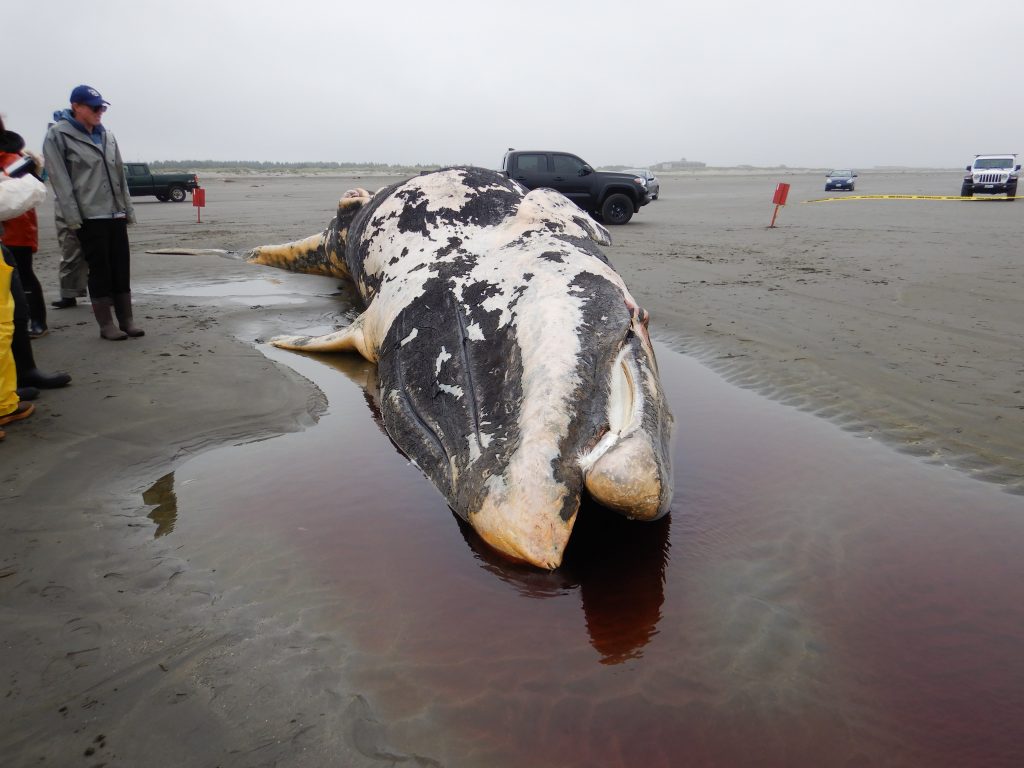In the second half of June, Cascadia Research and other members of the Marine Mammal Standing Network examined three dead gray whales in Washington. Preliminary results indicate malnutrition significantly contributed to the mortality in all three cases, consistent with findings in many other stranded grays in Washington waters in recent years.
Recent strandings included:
- A 42 ft female that was reported floating in Olympia on 20 June. This whale, first sighted alive but in poor body condition in mid-April in Bremerton, had spent several weeks in southern Puget Sound and was last seen swimming in Totten Inlet near Olympia on 17 June. With assistance from Taylor Shellfish, the carcass was towed to a suitable site for a necropsy to be conducted by biologists and volunteers from Cascadia Research and WDFW. As expected based on the body condition observed over the many weeks of monitoring, primary findings were poor blubber condition, lack of internal fat stores, and no food in the GI tract. There was no evidence of killer whale predation or vessel collision.
- A 39 ft adult male that washed ashore dead in Ocean Shores and was examined by Cascadia Research and World Vets with assistance from SR3 volunteers. This animal also had poor blubber condition, no internal fat stores, and no stomach contents. There were some internal indications of trauma, but the extent and severity of the injury could not be determined due to the position of the body.
- Finally, on 28 June, Cascadia and WDFW conducted an examination of a small gray whale in Grays Harbor. The whale had initially stranded alive on 27 June and was kept wet by local volunteers before it died early that afternoon as a larger team was being organized. The whale was just under 27ft (815cm) and was likely a yearling or small juvenile animal. Like the others, she was extremely emaciated. She also had injuries of an apparent recent entanglement but was not entangled when she came ashore.
Samples from all animals will be analyzed over the coming weeks and months and may provide additional insights into these mortalities. The poor nutritional condition seen in these whales has been documented in many others that have stranded in Washington during the ongoing Unusual Mortality Event (UME), the overall cause of which is still under investigation. These three most recent strandings bring the total in Washington state for this month (June) to 5 whales, and a year-to-date total of 13. This is above our annual average but much lower than the first year of the UME (2019), when 34 dead gray whales were documented.

Above: Gray whale examination on June 28th. Photo by Jessie Huggins, Cascadia Research, NMFS Permit 24359.

Above: Relocation of adult female gray whale for examination. Photo by Dyanna Lambourn, Washington Department of Fish and Wildlife, NMFS Permit 24359.

Above: Cascadia Research biologists examine an adult female gray whale in Southern Puget Sound. Photo by Jessie Huggins, Cascadia Research, NMFS Permit 24359.

Above: Adult male gray whale found dead in Ocean Shores. Photo by Jessie Huggins, Cascadia Research, NMFS Permit 24359.